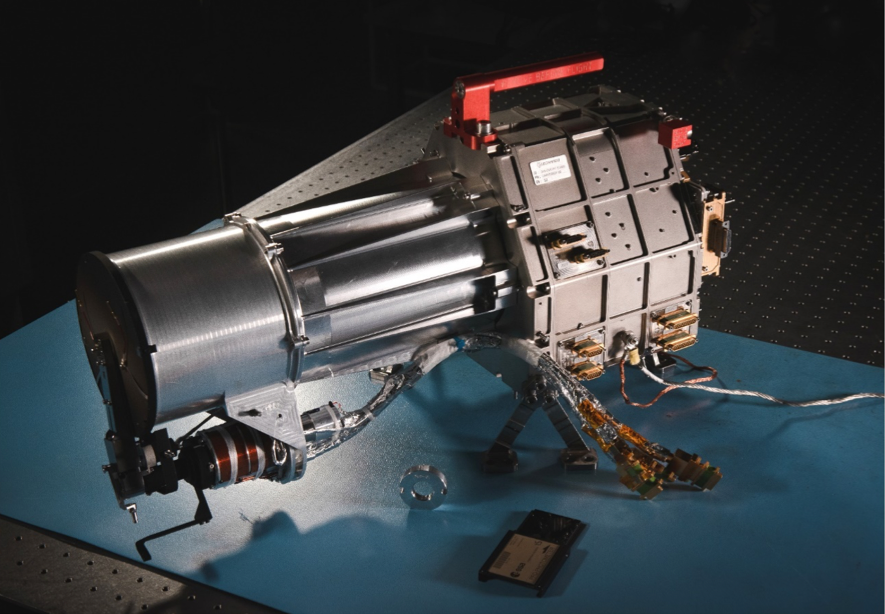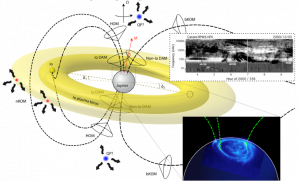
JANUS: Onboard JUICE:
The JUpiter ICy moon Explorer (JUICE) is an ESA-led mission with strong involvement from Japan. The “ONBOARD JUICE” series looks at the instruments on JUICE for which Japan has contributed hardware or expertise. An introduction to the mission and instrument overview can be found [here].
Author: Haruyama Junichi, lead researcher for JANUS-Japan
Quick fact sheet: JANUS

JANUS (Jovis, Amorum ac Natorum Undique Scrutator) is a camera system that obtains data for 13 multiple bands in the visible region in order to understand:
- What are the conditions for planetary formation and the emergence of life?
- What are the mechanisms for changing the Solar System environment?
JANUS will acquire Jupiter’s atmospheric information and topographical and geological information of the Galilean satellites (especially Ganymede).
The specifications of JANUS are as follows:
Aperture: 116 mm
Focal length: 467 mm
FOV: 1.29° x 1.72° (along track x across track)
Detector: Teledyne-e2v CMOS detector with 1504 x 2000 pixels
Detector pixel size: 7 x 7 µm2
Resolution: 7.5 m/pix from 500 km altitude
Number of Filter: 13 filters, covering the wavelength range 340 – 1080 nm.
JANUS will be able to observe the surface of Jupiter’s satellites with resolutions one order of magnitude higher than before, and in wider areas.
The surface of Ganymede has been differentiated into two types (dark and bright) terrains, referred to as a dichotomy. While the dark terrain has a relatively higher crater density and is covered with grooves, crater density within the bright terrain is lower, which implies that the bright terrain was generated more recently compared to the dark terrain. However, despite substantial study, the detailed mechanism to induce this dichotomy is still uncertain.
It has been indicated that Ganymede has a subsurface ocean. The answer to the question of the surface dichotomy is therefore likely related to interactions between interior activity and surface morphology of the satellite. The most important information to attack this problem is high resolution images of Ganymede.
The data obtained by JANUS will also elucidate the presence/absence and history of volcanic activity, morphology of volcanoes, the presence/absence of water-ice eruptions, soil contact reactions with water (ice), etc., and is expected to provide hints for understanding the environment in which life can exist.
JANUS is also expected to make great achievements in investigating the details of Jupiter’s atmospheric structure. Previous Jupiter exploration missions have shown that lightning discharges occur in the Jovian atmosphere as they do in the Earth’s atmosphere. For example, the latest radio and optical observations by the Juno spacecraft have revealed that lightning discharges frequently occur at high latitudes on the northern hemisphere side of Jupiter. However, the only observations of lightning discharges to date have been of the electromagnetic waves emitted by lightning discharges and snapshot optical observations by visible cameras. Therefore, it has not been clarified what kind of temporal changes are observed in the emission intensity and shape of lightning discharges.

Furthermore, we don’t know much about the horizontal and vertical convective structures of Jovian atmosphere where lightning occurs, nor how lightning is related to the bright and dark stripes, such as belts and zones. JANUS, on the other hand, is capable of capturing movie images of Jovian lightning discharges. This makes it possible to study the temporal and spatial variations of the Jovian lightning discharges in detail. Such observations will allow us to understand the mechanism of Jovian atmospheric structure and formation. Understanding the atmospheres of other planets rather than the Earth is also an important scientific challenge that is needed for understanding the origin and evolution of life.
Further information:
The JUICE Mission: Japan joins ESA to head to the icy moons
JANUS Fact Sheet
JUICE Japan website
 Previous Post
Previous Post Next Post
Next Post






